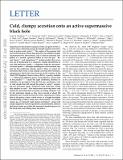Cold, clumpy accretion onto an active supermassive black hole
Author(s)
Tremblay, Grant R.; Oonk, J. B. Raymond; Combes, Françoise; Salomé, Philippe; Christopher, Philippe; O’Dea, P.; Baum, Stefi A.; Voit, G. Mark; Donahue, Megan; McNamara, Brian R.; Davis, Timothy A.; McDonald, Michael A.; Edge, Alastair C.; Clarke, Tracy E.; Galván-Madrid, Roberto; Bremer, Malcolm N.; Edwards, Louise O. V.; Fabian, Andrew C.; Hamer, Stephen; Li, Yuan; Maury, Anaëlle; Russell, Helen R.; Quillen, Alice C.; Urry, C. Megan; Sanders, Jeremy S.; Wise, Michael W.; ... Show more Show less
DownloadCold, clumpy.pdf (834.6Kb)
PUBLISHER_POLICY
Publisher Policy
Article is made available in accordance with the publisher's policy and may be subject to US copyright law. Please refer to the publisher's site for terms of use.
Terms of use
Metadata
Show full item recordAbstract
Supermassive black holes in galaxy centres can grow by the accretion of gas, liberating energy that might regulate star formation on galaxy-wide scales. The nature of the gaseous fuel reservoirs that power black hole growth is nevertheless largely unconstrained by observations, and is instead routinely simplified as a smooth, spherical inflow of very hot gas. Recent theory and simulations instead predict that accretion can be dominated by a stochastic, clumpy distribution of very cold molecular clouds—a departure from the ‘hot mode’ accretion model—although unambiguous observational support for this prediction remains elusive. Here we report observations that reveal a cold, clumpy accretion flow towards a supermassive black hole fuel reservoir in the nucleus of the Abell 2597 Brightest Cluster Galaxy (BCG), a nearby (redshift z = 0.0821) giant elliptical galaxy surrounded by a dense halo of hot plasma. Under the right conditions, thermal instabilities produce a rain of cold clouds that fall towards the galaxy’s centre, sustaining star formation amid a kiloparsec-scale molecular nebula that is found at its core. The observations show that these cold clouds also fuel black hole accretion, revealing ‘shadows’ cast by the molecular clouds as they move inward at about 300 kilometres per second towards the active supermassive black hole, which serves as a bright backlight. Corroborating evidence from prior observations16 of warmer atomic gas at extremely high spatial resolution, along with simple arguments based on geometry and probability, indicate that these clouds are within the innermost hundred parsecs of the black hole, and falling closer towards it.
Date issued
2016-06Department
MIT Kavli Institute for Astrophysics and Space ResearchJournal
Nature
Publisher
Nature Publishing Group
Citation
Tremblay, Grant R.; Oonk, J. B. Raymond; Combes, Françoise; Salomé, Philippe; Christopher, Philippe; O’Dea, P.; Baum, Stefi A. et al. “Cold, Clumpy Accretion onto an Active Supermassive Black Hole.” Nature 534, no. 7606 (June 8, 2016): 218–221. © 2016 Macmillan Publishers Limited, part of Springer Nature
Version: Author's final manuscript
ISSN
0028-0836
1476-4687